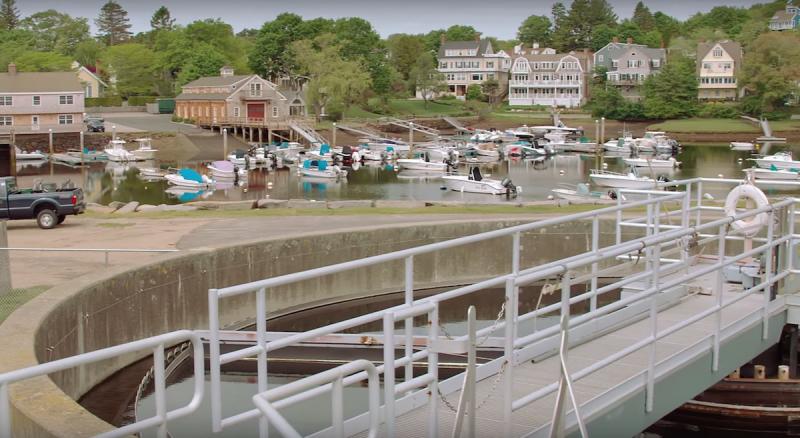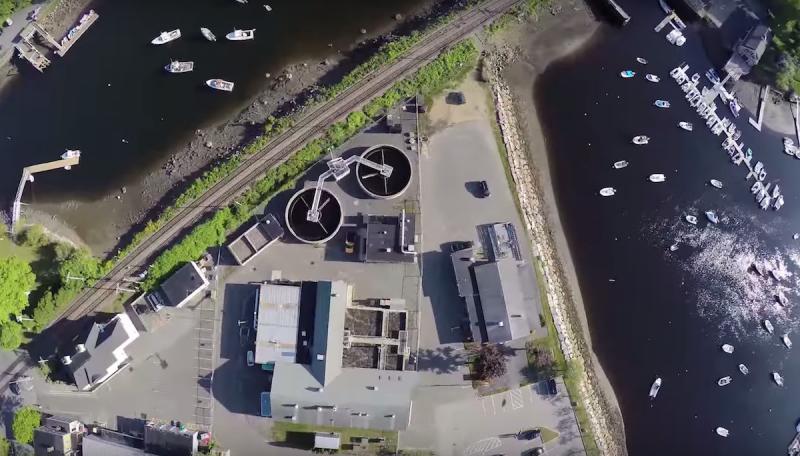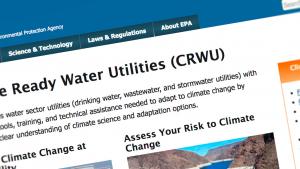Climate stressors and impacts
The town of Manchester-by-the-Sea is a community of just under 6,000 residents located on Cape Ann, Massachusetts, approximately 20 miles northeast of Boston. This coastal community—originally gifted by land grant to the Massachusetts Bay Colony in 1629—is now known for its picturesque harbor, beautiful beaches, and restored sea captain’s homes.
Manchester’s wastewater treatment plant is located right at Manchester Harbor. The harbor borders the Atlantic Ocean, and the plant is less than 10 feet above sea level. Because of its location, the plant is susceptible to flooding from extreme precipitation events, high tides, storm surges, and sea level rise. The plant site is within the Federal Emergency Management Agency's (FEMA) 100-year floodplain, indicating that it is at risk of inundation from flooding. During storms, it is not uncommon to see the parking lot adjacent to the treatment plant covered in four to six inches of water.
Nearly 18 years old, Manchester’s treatment plant was built to process an average flow of 1.2 million gallons of water per day (MGD). It was designed for a maximum daily flow of 3.0 MGD, and an instantaneous maximum flow of 5.0 MGD. When intense precipitation events occur, the plant must handle high rates of water inflow and infiltration to the collection system. Flooding places the plant's pumps and chemicals stored in the its headworks building at significant risk for malfunction and contamination.
Evaluating the infrastructure of the utility and its resiliency to climate-related hazards is critical to safeguarding a community by the water, especially with an increased occurrence of extreme weather events and factors associated with a changing climate. Town Administrator Gregory Federspiel says, “One of our biggest motivations to try and get ahead of the impacts of climate change is really a financial concern. To anticipate that is going to be less costly than trying to repair in a crisis situation.”
A wake-up call
In October of 2014, seven inches of rain fell in the area surrounding the wastewater treatment plan within 24 hours. Though the plant did not sustain significant damage, similarly intense rain events have led to street closings, public infrastructure damage, and private property damage in the past. Following the 2014 event, Manchester-by-the-Sea’s utilities embarked on a project to work with the U.S. Environmental Protection Agency’s (EPA) Creating Resilient Water Utilities (CRWU) program. The heavy rain event provided motivation for them to evaluate the potential impacts of climate change to their utility, look at ways to address these impacts, and prepare for the future.
Setting priorities and examining options
Using EPA’s Climate Resilience Evaluation and Awareness Tool (CREAT), the utility was able to examine maps of projected changes at their site based on several scenarios. These scenarios enabled Manchester’s water managers to analyze projected threats of heavy precipitation and flooding to the year 2035 and sea level rise and projected storm surge heights to 2060.
Based on "warm and wet" weather scenarios, water managers decided to focus first on building the resilience of their headworks building. They chose this building because it contains many of the influent (in-flow) and effluent (out-flow) pumps that would no longer be operable if flooded. Another factor in this decision was the building’s location; it sits entirely within the FEMA 100-year and 500-year floodplain. With their top priority identified, utility staff used CREAT again to facilitate discussion on changes that could be implemented to protect the assets of the wastewater treatment plant.
The assessment and evaluation process gave Manchester an opportunity to be proactive in their decision making and look for ways to better fortify the area around the plant to keep it functioning. Based on what they learned, the utility is evaluating adaptation options—such as relocating to an area with higher ground, or constructing a higher sea wall along Manchester Harbor. As Carol Murray, Interim Director of the Department of Public Works, says, “We have the opportunity to glimpse what the future may hold, but we also have the opportunity to change that.”





